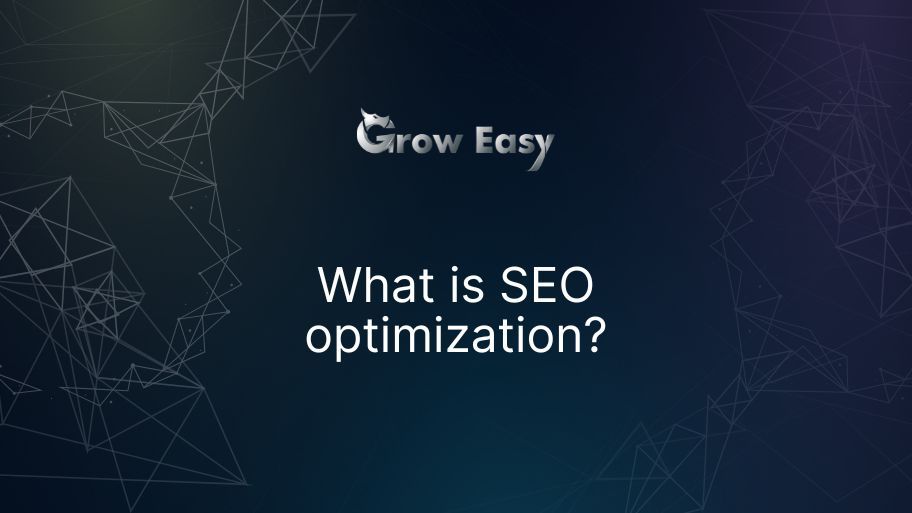SEO is a set of strategies and techniques that help your website rank higher in Google's search engine. The answer to the question What is SEO includes on-page and off-page optimization, the skillful combination of which is extremely important if you want to rank at the top.
This includes content optimization, improving your site's technical performance (such as loading speed, mobile responsiveness, site structure), link building between your site and other sites (off-page SEO), and many more strategies that I'll reveal to you a bit later in this article.
But what are all these efforts leading to? The answer is simple - you gain more traffic, ensure a better user experience on your site and ultimately - increase your revenue and profit.
If you want to learn how SEO works, what its basic principles are and how you can use it to your advantage, continue reading this room at Grow Easy.
We have prepared for you a lot of examples and useful and interesting information that is certainly worth reading.
Contents (updated March 2025):
1.What is SEO and what are its advantages?
2.Types of SEO | What is SEO
2.1 On-Page Optimization
2.2 Off-Page Optimization
2.3 Technical SEO
2.3.1. What does Technical SEO include?
2.4 SEO Copywriting | What is SEO
3.Does Google approve AI-generated content?
4.How long does SEO take?
4.1. Is your website new? | What is SEO
4.2 Are you using links from authoritative sites?
4.3. Do you share fresh content and are you familiar with AAET factors
5.Why is it important to know the user intent in SEO?
5.1. There are three main types of user intent:
6.Black-Hat SEO vs. White-Hat SEO | What is SEO?
7.Can anyone guarantee you results?
What is SEO and what are its benefits?
If you're wondering what SEO is, we can assure you that it's a necessity. Especially for websites that want to be visible, recognizable and grow. Just like yours.
According to recent research from Semrush, Google processes OVER 8.5 billion queries per day. And what does that mean for your business? If your website isn't at the top, you're losing a huge number of potential customers.
- The top position on Google receives an average of 22.4% of all clicks according to Semrush research.
- Tenth position - only 2.3% - or to put it another way - 10 times less according to the same Semrush study.
Another study by Ahrefs proves that 68% of all online experiences (so called user journeys) start with a search engine. And that makes using SEO a sure weapon to reach the right audience at the right time.
What are the main benefits of SEO for your business?
- More traffic to your website - The higher your website is ranked, the more potential customers will visit it.
- Reduce advertising costs - While paid ads on Google Ads require an ongoing investment, SEO delivers hot traffic without having to pay for every click.
- Increased trust and authority** - Users perceive first results on Google as more trustworthy.
- Better user experience - Optimization improves site structure, speed and content quality, leading to longer user stays and.. more orders.
- More Conversions - When your site appears to users who are already searching for your products/services, the likelihood of them making a purchase increases manifold.
- Sure advantage over competitors - If your site ranks higher than your competitors, the chance of customers choosing you is much higher.
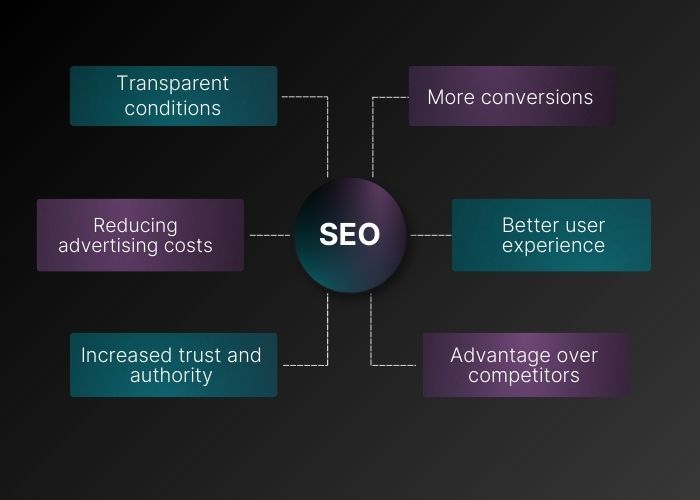
These benefits only reinforce the claim that SEO is a safe investment in sustainable growth for your business. Remember, if you're not on the 1st page of Google, you simply don't exist to many of your potential customers. And it's time to change that.
Types of SEO | What is SEO
Doing keyword/phrase optimization after performing keyword analysis, the work of a particular SEO business is divided into several main types,and all of them are related to the answer to the question "what is SEO".
They are all about optimization that will retain users, make their experience more enjoyable and ultimately - get them to take the desired action.
On-Page optimization
The focus here is solely on the internals of the site - improving the code, quality, speed. Links are created between different pages on the site so that Google's "robots" can more easily crawl and understand it.
Some of the most important aspects of On-page optimization are:
- ** Short and clear URLs.** If URLs are well structured and contain the main keyword, they will be more understandable for users (and search engines).
- Optimized meta data. The aim is to make the meta title and meta description engaging and contain the keyword.
- ** Structured headings (H1-H6).** Each page should have logically ordered headings and subheadings that follow the H1-H6 hierarchy.
- SEO-optimized copywriting. Keywords should be used naturally in the text without being "obvious".
- Image optimization. Each image should be in an appropriate format (e.g. WebP or JPEG for web), compressed for faster loading, and have descriptive Alt text that helps search engines understand its content.
The more pages and content there are on your website, the more work there is on it. However, this makes On-Page seo optimization much more meaningful and results can be seen faster. Some of the largest and most significant websites in the world only do On-Page optimization, as that is enough for them.
Off-Page optimization
This type of optimization (Off-Page Optimization) focuses solely on external factors and how they affect your site. The most popular are hyperlinks, which are built between different sites using keywords/phrases relevant to both businesses.
If you're wondering if your site meets the criteria, stop guessing! For a limited time, get a free analysis from one of our experts. Sign up HERE!
Technical SEO
Technical optimization plays a big role in answering the question "what is SEO" and is part of a working SEO strategy.
Everything else can work like a charm - great content, good link building, but if the site is technically flawed, the chances of ranking at the top simply "die".
This is the process by which you improve the technical aspects of your site to make it easily understandable to both users and Google's algorithms.
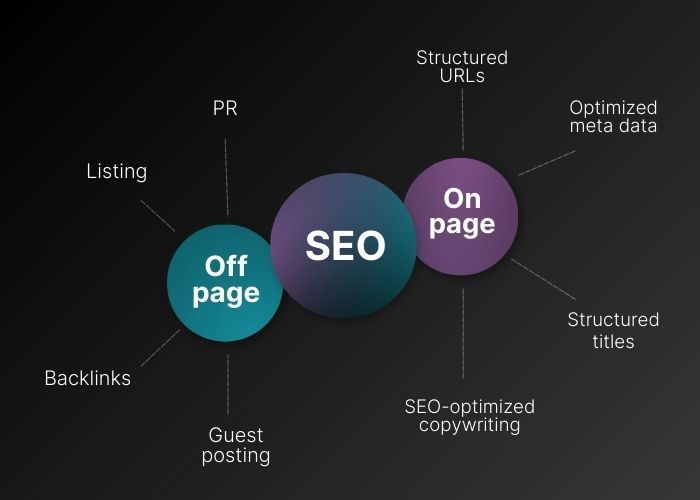
What does Technical SEO involve?
- load speed optimization - reducing the size of images by compression; minimizing the size of HTML, CSS, Java files are fewer requests to the server
- The mobile version - using responsive design; large enough buttons and text that are readable without problem from a phone
- The security (SSL certificate) - http sites are perceived as insecure by Google and it tries to prevent users from accessing them. And that costs you traffic and leads.
- Getting URLs structured right - avoid long and complex URLs that contain unnecessary characters
- creating an XML sitemap - use Google Search Console to submit the sitemap; include only important pages
- eliminating duplicate content** - identical content "confuses" Google. Check for duplicate pages using Google Search Console.
Each of these aspects helps search engines to more easily crawl and index your pages, and this directly affects rankings.
Have you heard about bounce rate? It's a metric that shows users who have left your site. Those who have "left" without taking any action. And what causes this? Slow loading of the site, technical errors. And Google will notice this.
We recommend that you monitor the bounce rate closely to identify potential risks and problems. The easiest way is to link your site to Google Analytics 4 and track user behavior.
It's important to make sure your website is technically sound, works fast, smoothly and seamlessly on all devices. After all, SEO isn't just about content and keywords - a solid technical foundation is what holds it all together.
SEO Copywriting | What is SEO
SEO copywriting is one of the most important elements of successful SEO and SEO articles. And without it, we couldn't fully answer the question "what is SEO".
Wondering why? The answer is simple - without quality content, even the best techniques won't get you the results you want. Think of it this way - you can have a perfectly structured website, fast page loads and flawless technical search engine optimization, but if your content isn't engaging and well-written, users will simply leave.
And with them - Google. Well-written SEO text should include the right keywords, but without sounding artificial. The idea is to balance between search engine algorithms and the actual people who will read your text.
If you combine useful information with well-chosen phrases and present it in a way that engages the reader, you have the formula for success. SEO copywriting isn't just writing - it's a strategy that turns ordinary words into a tool for more traffic, customers and sales.
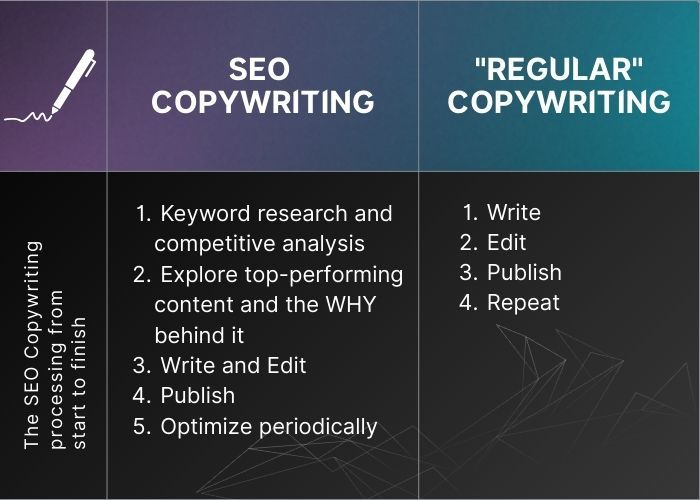
Does Google approve AI-generated content?
Yes, it's undoubtedly tempting to make our jobs easier by letting AI write out SEO text for us. Unfortunately though, Google does not approve of this approach at all especially when the content does not meet certain standards of quality and value.
Google themselves say they don't mind AI-powered content as long as it's useful, original and of high quality. AAET content remains a major factor for them, which you'll read about a little further down in the article.
For Google, businesses that use AI solely to create content to "manipulate" rankings violate their spam rules. And don't meet their SEO marketing requirements.
In this context, if your site relies mostly on AI-generated articles without editing by a real expert, Google may detect it and lower its ranking. And your site could be heavily penalized.
We share with you a real example from our practice. You can see for yourself how in March 2024 the traffic on this site dropped dramatically. From 2,000 impressions per month in May 2023, the traffic dropped below 100 impressions and so on for a whole year. (Fig.1)

And all because of an article written entirely by AI, which we unfortunately published without correcting. Now you can imagine what the consequences of such ill-considered actions really are, and how Google is not threatening us, but actually penalising violators of its rules.
How long does SEO take?
With SEO you won't get results instantly. It takes time. But it is not the only factor.
1. Is your website new? | What is SEO
If your site is brand new, Google first needs to index it and gather data about its content and user behaviour. In case the site already has a "history", you can spot results faster.
2. Do you use links from authoritative sites?
Yes, Google evaluates the quality of links, not just the number of links. If you get hyperlinks from authoritative sites in your niche, search engines will perceive your content as more credible. For example, if you sell clothes online, links from global fashion brands will be of high value.
3. Are you sharing fresh content and familiar with AAET factors
Google gives priority to sites that consistently publish relevant and useful content. This means it's important to create engaging content that covers the latest industry trends.
For Google, it is important that sites cover the AAET factors - authority, expertise, experience and credibility. And for that you need:
- Creating content that is trustworthy and experience-based.
- Cite credible sources and experts.
- To be active in your niche by sharing blogs, creating podcasts or social media posts.
If you meet these criteria, Google will appreciate it and rank your site higher in a shorter time frame.
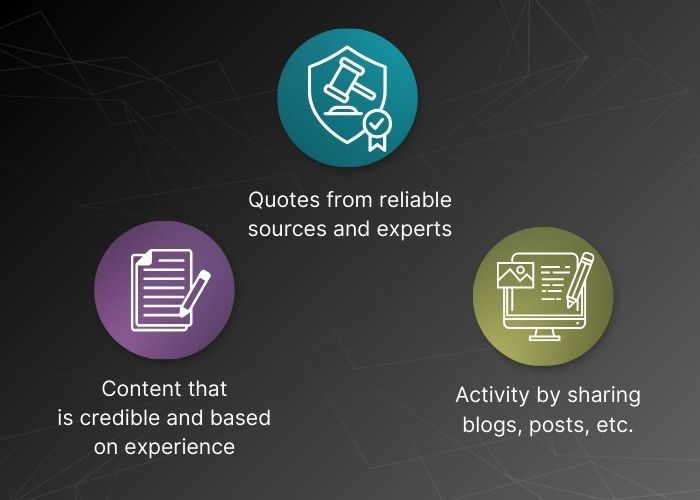
Why is it important to know user intent in SEO?
You probably already have a better idea of what SEO is. But do you realize that it's not just about getting the right keywords in the right places in the text, for example.
The real success behind the work comes when you understand exactly what users are looking for and why they're looking for it. And behind these actions is the term search intent - a key factor that determines whether your site will attract the right audience and meet their needs.
When someone searches for something on Google, they have a specific purpose - they might want information, they might be comparing products, or they might be ready to buy. Just like when you search for something on a search engine, you either want to buy something or see the different options on the market.
Search engines are increasingly focusing on displaying the most relevant results to the user's intent, not just pages that contain a relevant keyword.
There are three main types of user intent:
- Informational intent - when a user is looking for information on a topic/product/service, e.g. "How does SEO work?".
- Navigational intent - when searching for a specific site or brand, e.g. "Facebook login" or "Nike sneakers".
- Commercial & Transactional intent - when ready to make a purchase, e.g. "Best laptops for 2025" or "iPhone 16 Pro price".
Remember, if you don't understand your audience's user intent, you can't get the results you want. Take for example a product page written like a blog (more informative) and instead of offering a direct solution, will rather lead to loss of customers.
That's why in SEO you should not just target keywords, but analyze what's "behind" them. To do this, you can simply check what comes up in Google when you type in a keyword.
BONUS: When you type a specific word/phrase into a search engine, check the "People also asked" and "People also search for" fields. You can find a lot of good hits there (and you'll get a better idea of user intent).
Understanding user intent will help you create content that actually meets user needs. And you'll be able to attract more traffic and generate higher user engagement.
Black-Hat SEO vs. White-Hat SEO | What is SEO?
There is always a way to find a "hidden loophole" or some easier, though often less reliable, way to rank better in Google. Well, in the SEO world there are 2 main approaches: Black-Hat SEO and White-Hat SEO. And they are part of the answer to the question "what is SEO".
The differences between them are the quick but risky results and the long-term but sure success.
Black-Hat SEO involves techniques that attempt to "manipulate" search engine algorithms in order to quickly climb to the top positions in Google.
Some of them are: automatic content generation, creation of pages and sites for only 1 keyword with texts only for search engines, whose main purpose is to "submit" links to other pages; hidden content and hidden links through CSS, Java, HTML; scheme for buying links or exchanging links with other sites and many others.
On the other side is White-Hat SEO. This approach follows the rules and conditions of search engines. With it, results are achieved after creating quality content, good user experience and real links (be it internal or external).
White-Hat SEO is the complete opposite of Black-Hat SEO. With the former approach you are guaranteed sure, albeit slower results. With the second - you get fast results, but risk search engines "catching" you and penalizing you. And that's why it's very important to know the difference between these SEO services.

Can anyone guarantee you results?
"We'll get your website to the top of Google" is one of the biggest lies in the digital marketing world. No self-respecting SEO specialist or SEO company can guarantee you a high SEO position instantly. The factors on which this depends are really many.
However, at Digital Agency Grow Easy, we are the only ones in the market who make an additional commitment to the client when we start work. And we are the only agency that offers a legal guarantee to reach the first page of Google.
What we can promise is that our team will work 100% to achieve the desired results related to website optimization.
And last but not least - if you want to find a good SEO agency, it's best to ask someone who has worked with one. This way you will guarantee professionalism and responsible attitude towards your seo optimization in Google.
